
Content |
|---|
Characteristics "Savannah cat"
Coexistence is important that you have with your new friend. Before considering the acquisition of a cat of the breed "Savannah cat" you know certain factors. You must take into account their character, their need for exercise, their interaction with other pets, their care and if you have small children, their level of tolerance towards them.
Joy5.0 out of 5 stars (based on 1 review)
|
Activity level5.0 out of 5 stars (based on 1 review)
|
Friendliness to other pets4.0 out of 5 stars (based on 1 review)
|
|---|---|---|
Friendliness to children4.0 out of 5 stars (based on 1 review)
|
Grooming requirements1.0 out of 5 stars (based on 1 review)
|
Vocality3.0 out of 5 stars (based on 1 review)
|
Need for attention3.0 out of 5 stars (based on 1 review)
|
Affection towards its owners5.0 out of 5 stars (based on 1 review)
|
Docility3.0 out of 5 stars (based on 1 review)
|
Intelligence5.0 out of 5 stars (based on 1 review)
|
Independence2.0 out of 5 stars (based on 1 review)
|
Hardiness5.0 out of 5 stars (based on 1 review)
|
History
The Savannah is a breed of cat created in the United States in the decade of 1980. It is the result of the crosses between domestic cats (generally Egyptian Mau, Ocicat, Oriental shorthair cat and Domestic Shorthair) and servales males (Leptailurus serval). The latter is a medium-sized African wild cat with long legs., long neck and large oval ears. It shares a common ancestor with the lion and, having managed to adapt to various habitats, lives in the savannas, the forests or wetlands of your home continent.
The first Savannah was born the 7 in April of 1986. It was a kitten, daughter of a Siamese cat and serval male. It was baptized as “Miracle” by Judee Frank, the breeder who owns the cat. It must be said that it was really a near miracle for the breeder, since he didn't know that his Siamese I was pregnant. At that moment, housed a Serval quite fragile that, Obviously, he was responsible for “miracle”. Later, the Mrs. Suzi Mutascio acquired the miraculous female and renamed her as “Savannah”, name that the breed also received.
Patrick Kelly, another passionate breeder domestic cats wild looking, heard about Savannah and wanted to create a new race based on the “miracle”. As such, got in touch with Joyce Sroufe, an Oklahoma breeder specializing in breeding feral cats, including serval. He agreed to participate in the project and began to cross short-haired domestic cats with servales. So, all the kittens he offered for adoption were first generation hybrids (called F1). Your firsts Savannah They were born in 1994.
In 1996, in an effort to gain recognition for the breed, Patrick Kelly and Joyce Sroufe, In colaboration with Karen Sausman -a breeder of Bengalis– drafted a proposed standard for the Savannah, presented to the International Cat Association (TICA), the world's largest purebred domestic cat registration body. But, at the same time, this organization announced a moratorium on the recognition of new breeds.
This did not prevent other enthusiasts from taking an interest in savannah farming in the following years., and the breed became more and more popular. An association was even created in the year 2000 to promote the breed before the TICA. Originally called Savannah International Member & Breeder Association (SIMBA), this organization is now called simply Savannah Cat Association.
In February of 2001, TICA accepted the registration of the Savannah and allowed them to be displayed in cat shows, but not that they competed. That year more than a hundred. In 2006, the Canadian Cat Association (CCA) recognized the breed and its standard, which allowed to register the Savannah and participate in feline exhibitions organized under his authority. Regarding the TICA, was not up 2012 when he agreed to grant the same full recognition to the new breed.
In any case, as it usually happens with hybrid breeds, only dogs are allowed in cat shows Savannah from the third generation (F3). This generation is of special interest, since it is the one that can compete that theoretically has the highest percentage of Serval (although this rate may vary depending on the individual).
But, This generation is not recognized or cataloged by the American Cat Fanciers’ Association (ACFA) and Cat Fanciers’ Association (CFA) in United States; nor for him Governing Council of the Cat Fancy (GCCF), the World Cat Federation (WCF) and Fédération Internationale Féline (FIFé) in Europe.
Today, the Savannah cat is present all over the world, mostly in North and South America, Europe, Japan and Malaysia. But, is prohibited in some countries, like australia, where it was banned in 2008. Its great predatory capacity could pose a threat to the maintenance or even the survival of certain native species., with which it could compete if individuals were found in nature.
Some states, counties or cities in the United States also prohibit the possession of Savannah in its territory. Sometimes all representatives of the breed are prohibited, but sometimes only to the first generations. In other cases, a permit is required to own this cat. In summary, sometimes it's hard to navigate…
Physical characteristics
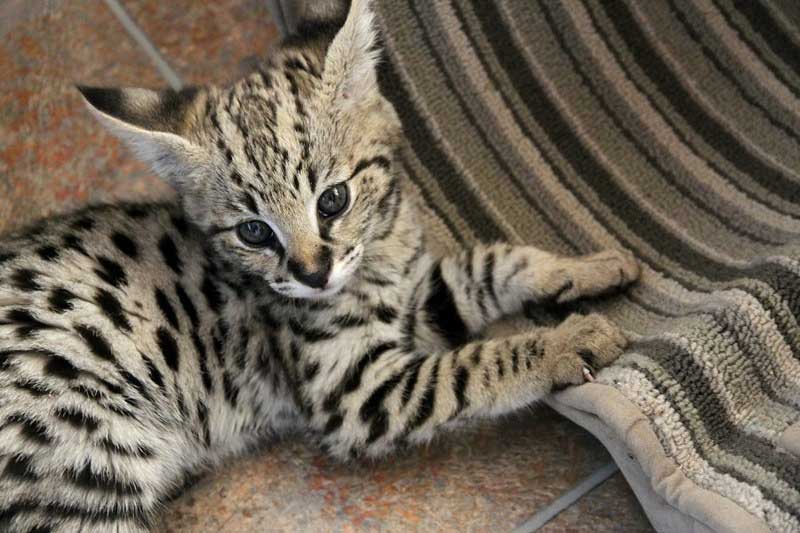
The Savannah is very large: in fact, a male was recognized in 2017 like the tallest cat in the world, with 48,3 centimeters at the withers. In fact, this breed has inherited several characteristics from its wild relative: it is a tabby cat with a spotted coat, a slim body, muscular and graceful, a head small, long legs, large ears and a slightly short tail. This is a type semi-foreign.
But, is significantly smaller than the Serval, and it also shows a noticeable difference in size from one generation to another. In fact, as they move away from the first generation of hybrids, the Savannah tend to be shorter in height and weight, between 6 and 9 kg. It also, in all generations, females are smaller than males.
There are some color variations in the Savannah. They can be inherited from one or both parent races. According to the standards of the International Cat Association (TICA), accepted colors are
The Savannah of this color are the most popular among breed enthusiasts, probably because its fur is the most similar to that of the serval. Your background color can be wheat, marten or saber, while its spots vary from orange brown to black and dark brown. Inside this fur color, it is rare to find adult cats with completely black noses.
This color is probably the second most popular. The background color of the coat ranges from very pale silver, almost white, even dark silver. Stains vary from carbon black to ink black. In some individuals, can cover a large area and be accompanied by hives; this pattern is called “marbled”. Some individuals of this color have a completely black nose.
The genetic inheritance of Silver Spotted Tabby comes from domestic cats that contributed to hybridization.
The Savannah of this color variation are black, but the root of her hair is white, which gives them a lighter coloration.
There is a servales melancholy, that is to say, blacks, in the nature. The corresponding color variation in the Savannah cat has been inherited from the genetic background of some servales with this property. Cats of this color are spotted, although their spots are usually visible only under strong light. These Savannah they always have a black nose.
But, in addition to those accepted by the TICA, there are other colors. Cats with these colors can even be registered with the association. In fact, sometimes they are more popular with some fans of the Savannah than officially accepted colors. It is about the following colors:
This coat goes from white to light gray, and the spots are light brown. The aquamarine blue of his eyes is the most noticeable feature of the Savannah snow. Although it is not accepted by the TICA, this rare color is highly prized by some breed enthusiasts.
The color lavender (ranging from cream to peach) is dotted with grayish spots. Again, this is a very rare color.
Size and weight
- Size: Of 40 to 45 cm.
- Weight: Of 6 to 12 kg
Breed standard
The breed standards are documents established by official bodies that list the conditions that a dog must meet. Savannah to be fully recognized as belonging to the race:
- Standard LOOF (Livre Officiel des Origines Félines)
- Standard AFC (Association Féline Canadienne)
- Standard TICA (The International Cat Association)
Character and skills
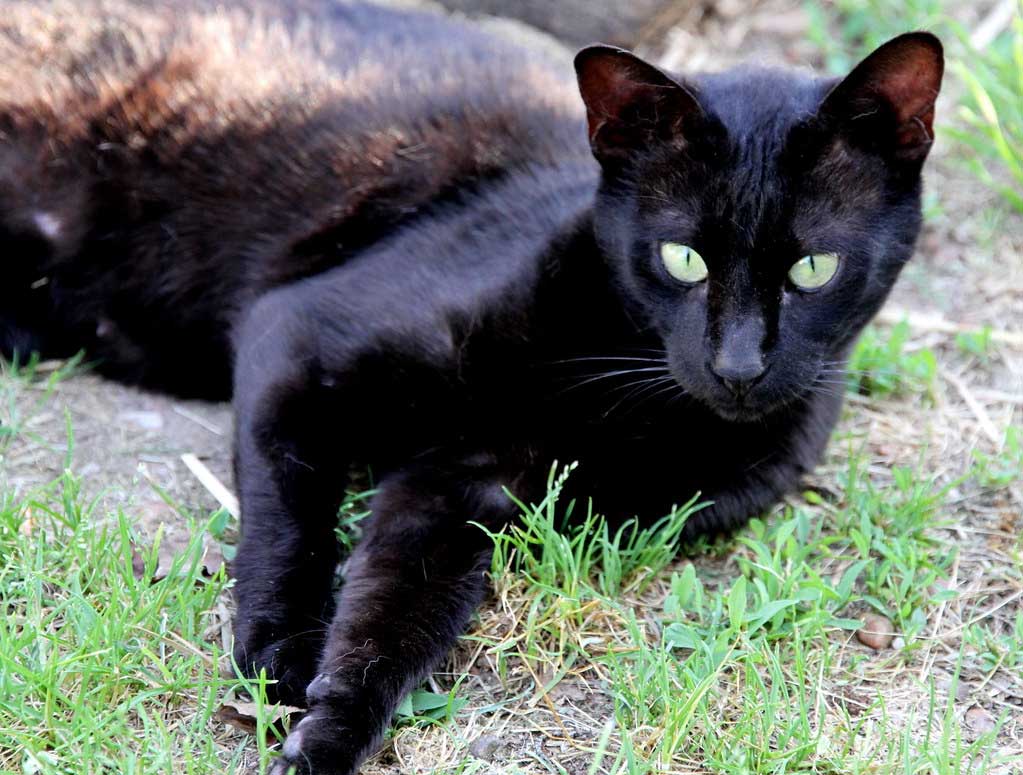
Despite his semi-wild ancestry, the Savannah is known to be a good-natured cat, affectionate, Gentile, loyal and playful from the first generations. He is also extremely smart, active and curious. It must be said that the serval, is contributing to your genetic makeup, It is a wild cat with a very familiar character and easy to tame. In some parts of Africa, in rural areas, servals can be used as companion cats or as hunting aids.
In fact, the owners of a Savannah often happily report that their pet is distinguished by character from any other breed of domestic cat.
Although they are not unhappy on the inside, they greatly enjoy the outdoors, allowing them to have fun climbing trees or hunting, and thus exhaust their unlimited energy. If you have your cat indoors, the best thing is that he has a large home where he can run, jump and climb with ease. A cat tree is essential to keep it active and prevent it from damaging furniture and curtains.
If you've gotten used to it from the start, can be easily walked on a leash. Like its relative the serval, the Savannah is one of the few domestic cats that enjoys frolicking in the water.
In general, to the Savannah loves the company of humans, as well as other pets in the home. They really enjoy being hugged and played with. But, la Savannah Cat Association (SCA) recommends that a first generation cat (F1) not be placed in a home with minor children. Young children love to pet and cuddle animals, but a Savannah F1 is a size that does not lend itself to such displays of affection. Although normally, when a cat is fed up, it just walks away, This SCA recommendation is a simple -but very wise- precautionary measure..
The association also suggests that small rodents or pet birds should not be left within reach of a savannah., since this could have a bad destiny for them. It also, owners who have an aquarium at home should ensure that it has a secure lid. If that is not the case, they can find their cat swimming among the fish, especially because Savannah they are water-loving cats.
Another precaution recommended by the SCA is for the owner to ensure that his Savannah do not have free access to the outside. If it escapes, the chances of me coming home are very low, and their chances of long-term survival in the wild would also be low. It has been established that a Savannah indoor can live up to 18 years, while their life expectancy in the wild is reduced to about 18 months.
Grooming and caring for the "Savannah cat"
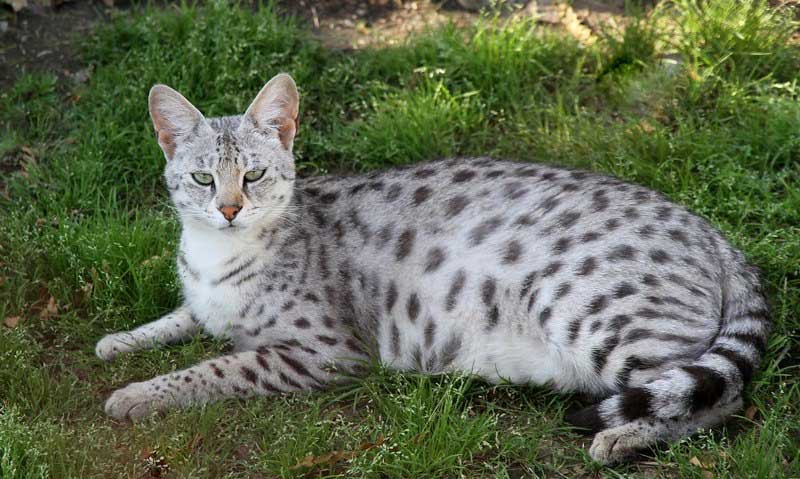
The smooth and short coat of the Savannah cat it is very easy to care for and does not require any special care. A weekly brushing is enough.
It also, as to the Savannah He likes water, can be bathed easily at times.
Indoor or outdoor cat?
The Savannah cat he is a hunter, jumper and climber much more skilled than other domestic cats. So, if kept as an indoor cat, needs a space above average, as well as varied and solid climbing opportunities.
It is also possible that the big cat is delighted to have a secure outdoor enclosure or garden.. With a little patience and a lot of practice, can also be taught to Savannah to walk on a leash. It is not advisable to keep the F1 to F4 generations as outdoor cats, as they are very valuable and also excellent hunters.
How much activity does he need? "Savannah cat"?
Due to his enormous agility and his great intelligence, the Savannah cat needs a lot of attention and activity. He does not like to be home alone and loves to follow his owner around the house. He likes to be the center of attention and will confidently tell you when he wants you to keep him busy..
An especially exciting activity for the Savannah cat is playing with the water or taking a bath in the bathtub. Some breeds like water so much that they will follow you into the shower. The cunning cats also learn to look for toys with gusto and run wildly all over the floor..
Health and nutrition
"Savannah cat" |
||
|---|---|---|
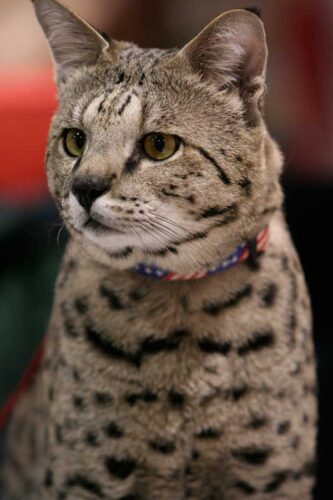 | ||
In general, the Savannah is in good health.
But, two hereditary diseases are known in this breed, that have their origin in the domestic cats that contributed to their birth. Are the progressive retinal atrophy and pyruvate kinase deficiency (a type of anemia). Both can be revealed by genetic testing, allowing serious breeders of Savannah identify and remove individuals carrying the defective genes from your breeding program. Any prospective buyer should require proof that the kitten they wish to adopt has been tested negatively.
The Savannah Cat Association (SCA) also advises owners of this breed of cats not to remove their claws. The declawing, which consists of the amputation of the last phalanx of the fingers, can cause pain that can last for the rest of the cat's life. Nail removal is not recommended for all breeds of cats, and is especially contraindicated for Savannah, due to the large amount of energy you need to expend, for example, clawing a cat tree.
It also, cats of this breed should be watched carefully when they are sick, as they can become dehydrated and lose weight quickly.
Last, the Savannah fear the cold.
Food
In general, the Savannah does not require any special diet. As with other cat breeds, it is only necessary to ensure the quality of the food that is offered.
But, for the Savannah of the first generation after hybridization (F1) and of the second generation (F2), some breeders recommend serving the animal a daily meal of raw poultry.
Other breeders recommend feeding all Savannah with a diet consisting of raw meat - minced- chicken and beef. But, this diet is discussed by some of your colleagues, they point out that it requires a good knowledge of nutrition, and that all the necessary ingredients must be added for a complete and balanced diet. If adopted, this practice should be done with caution, as over-supplementation can be harmful.
For sale "Savannah cat"
Before buying a Savannah cat, you should know that it is considered the most expensive breed of domestic cat in the world.
Depending on the generation, will pay between 1.000 and 10.000 euros for a kitten. Other difficulties may arise, especially when buying a cat from the F1 to F4 generation. These animals are not very easy to conserve and are subject to the Washington Convention on International Trade in Endangered Species. So that, if you want to import a cat from the USA. or from another non-EU country, there are many requirements, such as tenure and confinement permits.
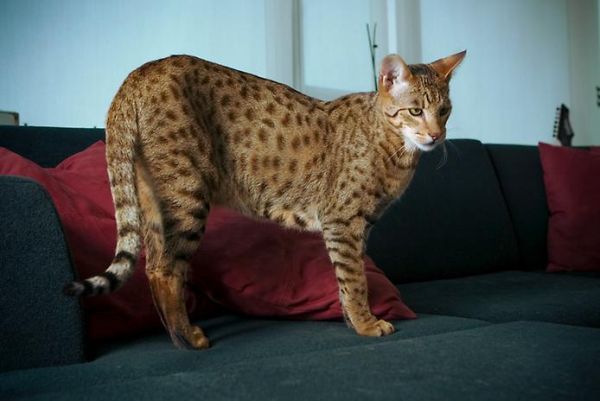 |
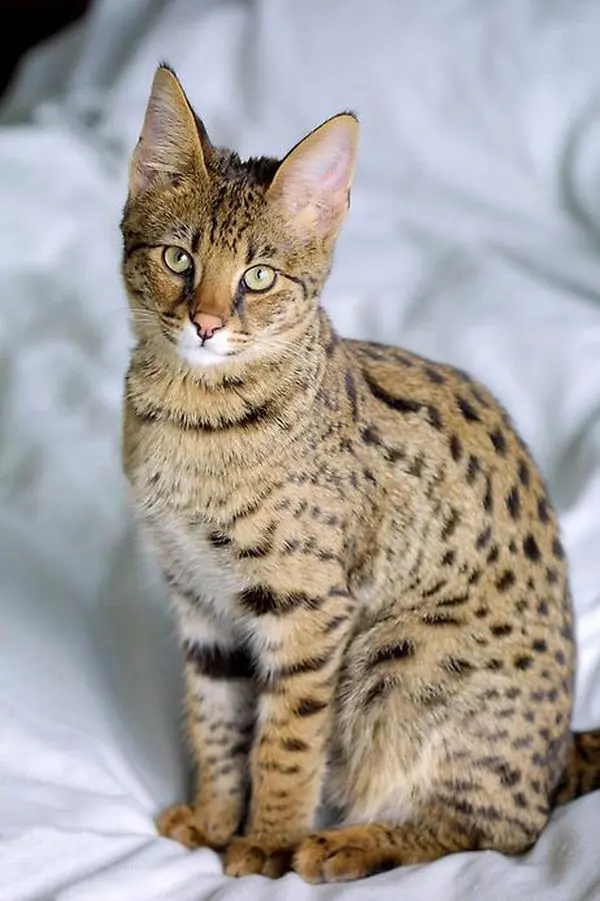 |
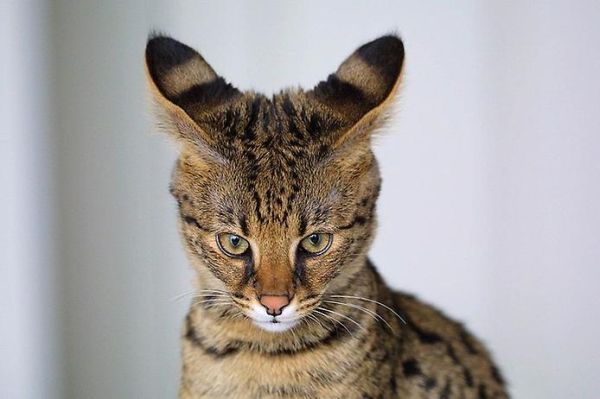
|
Interesting data
Criticism of breeding “Savannah cats”
The detractors of the breeding of the Savannah believe that mating a wild animal with a domestic cat for the sole purpose of obtaining a particular coat pattern is irresponsible.
As the gestation periods of cats and servales They are different, every generation of F1 is born prematurely.
The mortality rate, as well as stress for the mother, is therefore extremely high. Many of the so-called wild cat hybrids they continue to show the characteristics of a wild animal even after generations. So, keeping them species-appropriate is not possible for everyone.
Video Longest cat – Meet the Record Breakers |
||
|---|---|---|
|
youtu.be/TcTbsegeyug
| ||
In Australia and New Zealand, the Savannah they are even prohibited from entering the country because they can endanger biodiversity. So the question arises whether it is really necessary to travel a path that nature did not foresee., just to get a breeding goal.
One of the Savannah cats most famous in the world is Scarlett’s Magic, of United States. Received the Guinness record the largest living domestic cat in 2010, with a shoulder height of 45,9 cm.. She was also the longest domestic cat in the world, with a length of 108,51 cm..
But, the current record is held by the cat Maine Coon Ludo with a length of 118,33 cm..
Videos "Savannah cat"
|
|
|
|---|
Alternative names:
- Gato de la Sabana

Hello,
I hope my message finds you and everyone around you well.
I am looking for Savannah cats destination Switzerland.
How can you help me get 2 males and 1 female,
Please accept my most distinguished greetings,
Thanks.
contacts:
+221 76 762 62 13
WhatsApp: +221 77 521 07 07
Hello, I would like to know more about the Savannah breed, my email is carmenfa30@hotmail.com